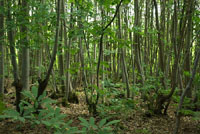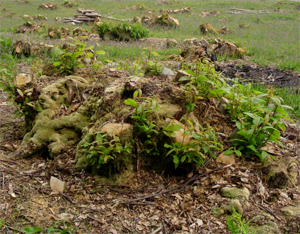Coppicing: An Introduction
Coppicing is a woodland management method in which the wood from a tree is harvested by cutting a suitable tree near ground level. It subsequently regrows over a period of years without needing to be replanted. This technique is different from pollarding, in which branches are cut at, or above, head height, leaving the possibility of grazing underneath the growing branches.
Coppicing is done on rotation: small areas of a woodland are cut each year in sequence leaving the areas not being cut to grow on for between 15 and 20 years for chestnut, and about 7 years for hazel. When an area of coppice is cut, it is all cut down, and creates a clearing. This periodic coppicing encourages the individual trees to live for up to hundreds of years. If the coppice cycle is managed correctly it can increase biodiversity in the woodland because of the beneficial effects of varying light levels reaching the woodland floor, and the range of different aged trees and stools in the woodland.
The best time to coppice chestnut is well after the autumn leaf fall when the sap has gone down, and certainly well before the sap rises in the spring.
 The basic procedure for coppicing chestnut is as follows:
The basic procedure for coppicing chestnut is as follows:
- Clear out all leaves and other debris around the base of the stool.
- Cut and clear away any dead or dying stems.
- Progressively cut each stem starting with the most accessible sections and working in to the centre of the stool. Ideally one cut should be made about 1-2 inches above where the branch grows out of the stool. That cut should be angled some 15 to 20 degrees from horizontal with the lowest point facing outwards from the centre of the stool.
- In some cases it maybe necessary to make a first cut higher and then trim back as above.
Remember to:
- Fell away from the wind and fell all the poles in one direction.
- Make sure you are working upwind of any campfire
- Always leave a fire in a safe condition when leaving the woodland.
 Once cut, the poles produced are usually processed to some extent in the woodland: they are often cut to length, and perhaps de-barked. In many cases the coppicer will process further and create spiles (stakes or strong fencing posts), or will split the chestnut into various sizes for fencing. Some even make hurdles for keeping sheep in pens.
Once cut, the poles produced are usually processed to some extent in the woodland: they are often cut to length, and perhaps de-barked. In many cases the coppicer will process further and create spiles (stakes or strong fencing posts), or will split the chestnut into various sizes for fencing. Some even make hurdles for keeping sheep in pens.
An approximate guide the diameter of felled coppice for further processing is:
- Lathes: 1” to 1½”
- Tree stakes: 1½” to 2”
- Fencing Stakes: 2” to 3”
- Straining posts: 4” to 5”
- Post and Rails for cleaving: 6” to 8”
In the UK the main trees that are coppiced are sweet chestnut, hazel and hornbeam. Chestnut has traditionally been used for fencing whereas hazel is more likely to have been used for thatching, hedge-laying spars and hurdle making. Hornbeam was used for charcoal making.
Historically chestnut coppice growing has been strongest in the south East of England, especially Kent and East Sussex. Although it is said that the Romans introduced it, there is some evidence that coppicing was practised in England in Neolithic times. There are many areas of the UK where hazel and hornbeam have been grown, but the Midlands and Devon still have much hazel woodland useful for the remaining thatchers.
Comments are closed for this post.
Discussion
There is a new website with a discussion forum dedicated to coppice.
http://www.coppice.co.uk
Hello to all,
I am a local coppice worker based in kent and i am looking for chestnut to coppice this winter. Preferebly 20+ years old for post and rail fencing.
I am also looking for standing firewood
I work all over Kent and Sussex and will pay good money for standing timber
I have a list of references
15 years experience
Please call 07774080914 or email me [email protected]
Many thanks
Dan Hawkins
Hello All
What a super website! I have just planted some Field Maple and a Beech as part of a mixed hedgerow, it’s very young, about 3′ high and only one thin main stem on each plant. Can anyone please advise me how long I need to wait before cutting, at what time of the year, and to how low down to cut? My aim is to eventually have a dense hedge of about 4 1/2′ high.
Also, this is my first, short run of hedge but I do want to plant a fair bit more. In addition to the Field Maple & Beech I’ve used a few mixed hollies, can anyone suggest other species to add in the next run? I live in the South East (Essex).
Thanks so much, Angela
“chainsaw training in East Sussex – near Rye?”
Is Plumpton college anywhere near?
“a lot of the trees were cut down prior to the sale.”
Sounds like a felling license would have been needed which would usually include a requirement to replant (grants available) and other official complications. You should have details on your sale documents or contact your Forestry Commission local office.
Hi Carole
Try the suppliers directory in the site – http://www.woodlands.co.uk/owning-a-wood/suppliers-directory/tree-nurseries/. It’s under the “Owning a Wood” tab & there’s a sub-section for tree nurseries. There’s lots of really useful information in the “Owning a Wood” section and it’s well worth a look for general advice, tree id, suppliers, contractors and training providers.
good luck with your new woodland!
Catherine
Hello everybody,
My husband and I have just purchased a piece of woodland in Wiltshire. Unfortunately a lot of the trees were cut down prior to the sale. We would like to replace some trees but do not know where the best place is to buy them. Can anybody help with a bit of advise please.
Carole
Hi out there
I am trying to find a supply of coppiced chestnut in 2 metre lengths, with a top diameter of no more than 2″. Anybody have a contacts or supplies which I can buy.
Jan
Hi Phil,
I would recommend cutting Ash for the first tierm at 20 yeaRS.
I would make the cut within 6″ of the ground. I always slope the cut so that the rain rund off it.
Phil
Neil, I just came across a list of trees that coppice in Woodlands by Rackham, and we got a book called Trees in Britain and their timbers by A L Howard, which is really good. Its an old one ;-)
Tracy
Hi John
According to my other half:
4 tons of wood per hectare- a ton is more than a cubic metre.
But this varies accoring to the climate and health of the trees
Tracy
Hi Phil
BTCV wrote a great book on coppicing, available on line, hopefully you will find what you need to there. I know that for chestnut, we cut as low as we can, otherwise after a few years the stool becomes very high!
http://handbooks.btcv.org.uk/handbooks/content/chapter/690
Tracy
Nice article.
Would it be possible to add a full list of native hardwoods that are suitable for coppicing, plus their uses? Ash,cherry, willow and alder spring to mind – the first two for firewood, the second two are marvellous for kindling when cut at 1 or two years. Also ash and, surprisingly, willow for tool handles.
Having just read the delightful book “Wildwood” by Roger Deakin, I now know what ‘coppicing’ means (how ignorant can one be?). This story of trees is one of the most splendid books I have ever read in my 80+ years. So, thank you for your explanations.
Cheers for the intro. I really needed something like this for a science project I’m doing.
[…] of the ancient woodland in the UK has been managed by coppicing (see http://www.woodlands.co.uk/blog/conservation/coppicing-an-introduction/ ) and some by pollarding. What tips would you give for identifying ancient woodland? Please use […]
At what age and where on the tree would I make the first cuts after planting ASH? I understand the the normal cutting height is about 1 metre for established stools.
Can anyone advise me on how many acres of wood land I need to produce 15 cubic meters of split logs on a yearly basis. The main tree being coppiced chestnut
thanks
There’s pictures of us coppicing our wood on our blog:
http://peplers.blogspot.com/2008/01/biggest-chestnut.html
Mike
We are beginning to coppice our woodland this year (it has been unmanaged for a while) and I am able to find a market for most of the wood. I would just like to encourage people to look around to see what you can sell, its amazing how many people are wiling to buy some!
Tracy
[…] do in your own or a friend’s woodland. Timber used is usually a by-product of woodland management. Coppiced timber in its green state is easier to cut, shape and turn than is seasoned […]
Is anyone able to give some advice on where we could get chainsaw training in East Sussex – near Rye?
Of course it goes without saying that coppice trees are planted as such and one would not try coppicing mature trees which would probably die – depending on species! Beech has been traditionally coppiced, as on Cornish “hedges” ( http://handbooks.btcv.org.uk/handbooks/content/section/1627 ) but some of these have not been coppiced for many years and are probably too large to bring back into coppice now although very desirable as the beech will get too big for the “hedge”. Where these are situated by roadside and overmature beech cannot be tolerated then the sooner an attempt at re-establishing a coppicing regime the better. Different cultivars may respond differently but probably best to start with say cutting three widely separated stools and see if they survive after two seasons (may shoot in first season and die second!). The whole process could take 10 years for one unit! Has anyone had experience of doing this?
Thanks! I would love to get involved in that sort of thing
Thanks! a nice little introduction!

For anyone looking for a coppicing course, Phil Hopkinson is running some in October & November:
2 days (24-25 October 2009 and 14th -15th November 2009 at Ravenshill woodland reserve, Alfrick, Worcs.
The course is an introduction to coppicing for people who have no experience at all or volunteer’s who have a little experience but would like to gain more knowledge.
The course will include tree identification, the benefits of coppicing, a walk through the wood looking at the differences in habitat between native woodland and conifer plantations.
Coppicing, coppice restoration, working methods, material selection and processing and material storage and building work breaks.
All tools will be provided. The course will be conducted outdoors so please bring suitable clothing for weather conditions. Hot drinks will be provided.
For more information about my courses visit http://www.malverncoppicing.co.uk
Cost: £95 for 2 days
To reserve a place on this course please send a deposit of £20 to:
Phil Hopkinson
159 Pickersleigh Rd
Malvern
Worcestershire WR14 2SH.
E_mail [email protected].
http://www.malverncoppicing.co.uk
Catherine
15 October, 2009